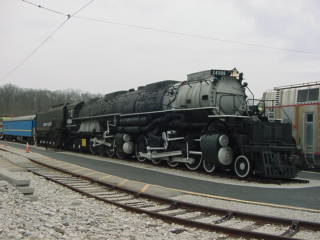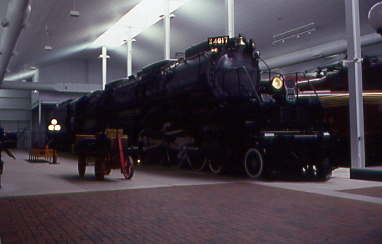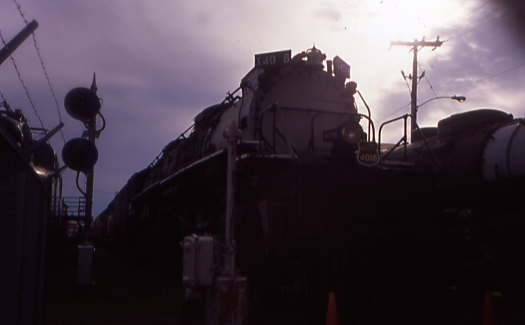The big day was finally here and I could not wait to see Union Pacific Big Boy 4014 and my old friend, Union Pacific 844, come through Echo Canyon.
Big Boy HistoryThe American Locomotive Company 4000-class 4-8-8-4 locomotive, popularly named Big Boy, is an articulated, coal or oil-fired, steam locomotive manufactured between 1941 and 1944 and operated by the Union Pacific Railroad in revenue service until 1959.
The Big Boy fleet of twenty five locomotives was initially built to haul freight over the Wasatch mountains between Ogden, Utah and Green River, Wyoming. In the late 1940's, they were reassigned to Cheyenne, Wyoming, where they hauled freight over Sherman Hill to Laramie, Wyoming. They were the only locomotives to use a 4-8-8-4 wheel arrangement consisting of a four-wheel leading truck for stability entering curves, two sets of eight driving wheels and a four-wheel trailing truck to support the large firebox.
According to a Union Pacific executive, this 4000-class 4-8-8-4 series originally was to have been called the "Wasatch". One day while one of the engines was being built, an unknown worker scrawled "Big Boy" in chalk on its front. With that, the legendary name was born and has stuck ever since.
Restoration of Union Pacific 4014Union Pacific 4014 is now undergoing restoration to operating condition after its re-acquisition by the Union Pacific Railroad in time for the 150th Anniversary of Promentory Point in 2019 in Utah. This engine was donated to the Railway & Locomotive Historical Society in December 1961. The Railway and Locomotive Historical Society, Southern California Chapter, operator of RailGiants Train Museum, returned Big Boy No. 4014 to Union Pacific for that purpose. In 2014, Big Boy 4014 arrived at its restoration facility in Cheyenne, Wyoming. Seven other Big Boys have been preserved elsewhere in various museums:
Union Pacific 4004 at Holliday Park, Cheyenne, Wyoming.
Union Pacific 4005 at Forney Transportation Museum, Denver, Colorado.

Union Pacific 4006 at Museum of Transportation, St. Louis, Missouri.
Union Pacific 4012 at Steamtown National Historic Site, Scranton, Pennsylvania.

Union Pacific 4017 at National Railroad Museum, Green Bay, Wisconsin.

Union Pacific 4018 at Museum of the American Railroad, Frisco, Texas.
Union Pacific 4023 at Kenefick Park, Omaha, Nebraska.
DesignUnion Pacific introduced the Challenger-type locomotives in 1936 on its main line over the Wasatch Range between Green River, Wyoming, and Ogden, Utah. For most of the route, the maximum grade is 0.82% in either direction, but the climb eastward from Ogden, Utah, into the Wasatch Range reached 1.14%. Hauling a 3,600-short-ton freight train demanded double heading and helper operations, and adding and removing helper engines slowed operations.
To eliminate the need for double heading and helper operations, Union Pacific decided to design a new locomotive. For such a locomotive to be worthwhile, it would have to be faster and more powerful than slower locomotives like earlier compound 2-8-8-0s that UP tried after World War I. To avoid locomotive changes, the new class would need to pull long trains at a sustained speed of 60 miles per hour once past mountain grades. In fact, it was designed so that it could travel smoothly and safely at 80 miles per hour - even though it was not intended to be used that fast.
Led by Mr. Otto Jabelmann; the head of the Research and Mechanical Standards section of the UPRR (Union Pacific Railroad) Mechanical Department, the UP design team worked with ALCO (the American Locomotive Company) to re-examine their Challenger locomotives. The team found that Union Pacific's goals could be achieved by enlarging its firebox to approximately 235 by 96 inches, increasing boiler pressure to 300 psi, adding four driving wheels, and reducing the size of the driving wheels from 69 to 68 in on a new engine. The new locomotive was carefully designed not to exceed an axle loading of 67,800 lb, and achieved the maximum possible starting tractive effort with a factor of adhesion of 4.0.
The Big Boys are articulated, like the Mallet locomotive design. They were built with a wide margin of reliability and safety, and normally operated well below 60 miles per hour in freight service. Peak horsepower was reached at about 41 mph. The maximum drawbar pull measured during 1943 tests was 138,000 lbs while starting a train.
Without the tender, the Big Boy has the longest engine body of any reciprocating steam locomotive. The 1944 4884-2 series Big Boys were also arguably the heaviest steam locomotives ever built, at 1,208,750 lbs for engine and tender, and 772,250 lbs (engine only) in working order. There is some speculation that the first series of C&O H8 2-6-6-6 engines may have weighed as much as 778,200 lbs, but during subsequent re-weighs of early production H8's under close scrutiny by the builder and the railroad owner, all engines were found to be less than 772,250 lbs.
The Railway and Locomotive Historical Society, Southern California Chapter, operator of RailGiants Train Museum, returned Big Boy No. 4014 to Union Pacific for that purpose. In 2014, Big Boy No. 4014 arrived at its restoration facility in Cheyenne, Wyoming.
ManufacturingThe American Locomotive Company manufactured 25 Big Boy locomotives for Union Pacific; two groups of ten in 1941 and one group of five in 1944.
The Big Boy locomotives had large grates to burn the low-quality bituminous coal from Union Pacific-owned mines in Wyoming.
OperationsAs an experiment, Locomotive 4005 was converted to burn oil; unlike a similar effort with the Challengers, it failed due to uneven heating in the Big Boy's large, single-burner firebox. Another experiment that took place for a short time was giving locomotive 4019 smoke lifters, similar to those found on locomotive 844. They were later removed, as the Big Boys' nozzle and blower were able to sufficiently blow the smoke high enough to get it out of the engineer's line of sight.
Postwar increases in the price of both coal and labor and the efficiency of diesel-electric motive power foretold a limited life for the Big Boys, but they were among the last steam locomotives taken out of service. Although designed to pull 3,600 short tons over the Wasatch, the Big Boys' ratings were increased several times until they were eventually rated at 4,450 short tons on that line.
The last revenue train hauled by a Big Boy ended its run early in the morning on July 21, 1959. Most were stored operational until 1961 and four remained in operational condition at Green River, Wyoming until 1962. Their duties were assumed by diesel locomotives and gas turbine-electric locomotives.
The MorningThis morning Robin and I arose at 4:45 AM and left the Radisson Hotel after 5:00 AM, driving east to the exit to Park City. We filled up my car with petrol and picked up some donuts for me to snack on then drove Interstate 80 east to Castle Gate then reversed to the westbound rest area where we parked. We waited for Bob and Elizabeth to arrive while Robin took a nap. Once the four of us were together, Elizabeth and I climbed through the wet dirt (muck) to the top of the west hill, Bob would be at the table area and Robin on the east hill. It was off and on rain with us joking that we all must be crazy to be standing here waiting for a Big Boy to arrive. We did, however, have trains to practice with.
The photo location. The first train came after an hour of waiting.
Union Pcific 7971 East was our first train of the morning.
Union Pacific 6016 West came through and we practiced with that one.
Photographers were covering the hills waiting for the Big Boy to arrive.
Big Boy 4014 and Union Pacific 844 made an impressive show coming down Echo Canyon. I was amazed to see it and very happy I got up this morning to witness it in person. After we climbed off the hill on a different path and cleared the muck off our shoes, we visited the rest area's information area which had a lot of excellent displays. Elizabeth and I came back together and stopped at MacDonald's before returning to Salt Lake City, filled the car and returned to the Radisson Hotel. I wrote this story and next was a trip on the FrontRunner train and also to finish up the light rail miles later this afternoon out to the airport.
| RETURN TO THE MAIN PAGE |